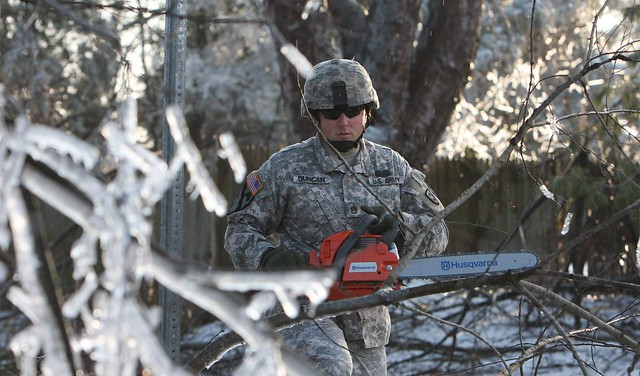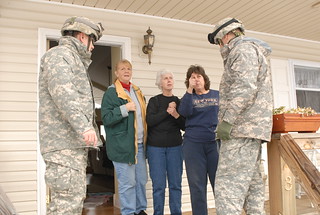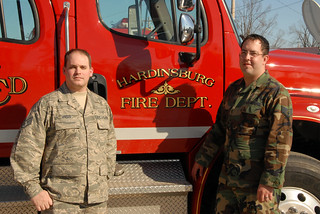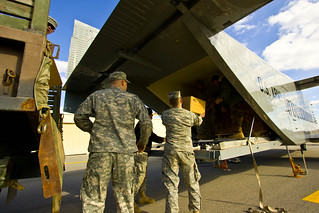Story by David Altom, Kentucky National Guard Public Affairs
[caption id="" align="aligncenter" width="576"]

Ice-covered branches provide a fitting background as Staff Sgt. Erick Duncan, Company A, 149th Brigade Support Battalion, walks down a street in Mayfield, Ky., Friday, Jan. 30, 2009 during a road clearing mission. The Soldiers used chainsaws to cut up branches lying near the city streets. Fellow Soldiers moved the branches off the street. (Kentucky National Guard photo)
FRANKFORT, Ky -- In January 2009 Kentucky experienced what Gov. Steve Beshear described as "the worst natural disaster in Kentucky's history." Twenty mph wind gusts drove the wind chill to sub-zero levels and 10 inches of snow fell on top of three inches of ice, a recipe for catastrophe from Pikeville to Paducah. Water lines burst and power lines snapped, leaving nearly 800,000 customers without electricty -- and life stustaining heat. More than 100 counties declared states of emergency and FEMA declared the entire state a disaster zone. Experts would later say that the 2009 winter storm surpassed all aspects of Hurriane Ike.
[caption id="" align="alignleft" width="320"]

Army Spc. Harold Hoskins (l) and Sgt. Joshua White (r) of the 206th Engineer Battalion talk with residents of Leitchfield, Ky. as part of a door-to-door health and welfare visit program conducted by members of the Kentucky National Guard.
On January 31 Governor Steve Beshear directed Kentucky's adjutant general, Maj. Gen. Edward W. Tonini, to order the unprecedented activation of all Kentucky Army National Guard units, along with selected portions of the Kentucky Air National Guard. This was the largest state call up of Kentucky National Guard forces in the history of the Commonwealth. It represented the strongest possible effort to relieve human suffering and ensure the safety and well-being of our citizens. The order placed 4,600 troops (nearly 3,700 Army Guard Soldiers and 320 Air Guard members) into the effort to address the needs of the people of the Commonwealth during this winter storm.
In comparison, more than 800 Kentucky Guard Soldiers and Airmen were deployed in support of Operations Iraqi Freedom, Enduring Freedom and Noble Eagle. The state activation exceeded troop levels for the 1997 flood (1,600 troops) and Kentucky's support of recovery efforts following Hurricane Katrina in 2005 (approximately 2,000). The order did not include Guard members who were college students or who had not completed basic training.
Joint Task Force Kentucky was formed to coordinate the massive Army and Air National Guard effort, establishing command and control in five subordinate task forces arrayed across the Commonwealth. Restoration of electric power to water plants, communications facilities, shelters and homes were the top priority across the state. Troops worked with state and local crews in clearing road and creating access to damaged power transmission lines.At one point Kentucky Guard officials announced the delivery of more than 450,000 meals to local communities, along with a schedule to bring in 285,000 meals every day until the crisis was over. In addition to the meals, nearly a million bottles of water were handed out in regions where residents have no access to clean water, with a half million bottles of water coming in on a daily basis.
The bulk of the Guard's mission eventually moved west of I-75, with an emphasis on Benton, Leitchfield, Greenville, Madisonville, Paducah, and communities in between. Troops focused on the restoration of electric power to water plants, communications facilities and homes. Using chainsaws and elbow grease they cleared routes for emergency response vehicles as well as helped utility crews gain access to damaged power transmission lines.
[caption id="" align="alignleft" width="320"]

Staff Sgt. Thomas Moses and Staff Sgt. Jason Scharf identifed the two carbon monoxide poisoning victims today during wellness checks conducted in conjuction with Darren Voyles, a firefighter with the Hardinsburg City Fire Department. (Photo by Tech. Sgt. Dennis Flora / KyANG)
Ten deaths were attributed to carbon monoxide poisoning from the use of generators and fire in homes. Guard members assisted local civilian authorities with life-saving wellness checks. Two Airmen from the Kentucky Air National Guard who, along with local authorities, were credited with saving an elderly couple from carbon monoxide poisoning during the a door-to-door wellness check in Breckenridge County. The couple were treated at a local hospital and released.
Click here to read about Guard "wellness check" saves couple from carbon monoxide poisoning
"This is indeed a monumental effort," declared Maj. Gen. Tonini. "Never before have we mobilized so many troops for such an important cause. From Hazard to Paducah, Kentucky has been dealt a major blow with this winter storm and it caught a lot of people unprepared. Indeed, the very safety and welfare of our fellow Kentuckians is at stake and we will be here until the end."
[caption id="" align="alignright" width="320"]

Soldiers of the 307th Component Repair Company prepare to transfer MREs from a C-23 Sherpa to a 2.5-ton truck for transport to the distribution facility at Wendell H. Ford Regional Training Center in Greenville, Ky. on Mon., Feb. 2, 2009. The Kentucky National Guard is distributing its stock of MREs to residents who have lost power due to the winter storm that has ravaged the state.
Establishment of shelters and points of distribution for essential supplies were also prime missions for Guard Soldiers and Airmen. The newly constructed Armed Forces Readiness Center in Paducah was transformed into a way-station for equipment and supplies brought in by FEMA.
Other states joined Kentucky in the winter storm relief effort. Members of the West Virginia National Guard sent 50 engineers and their equipment to assist in debris removal. The Florida National Guard contributed a communications unit and several truckloads of equipment to help state and local official bridge communications shortfalls in West Kentucky. The Florida Guard team joined Kentucky Guard communications experts to establish operations in 10 locations throughout western Kentucky. Other out of state resources also include 180 humvees on loan from Guard units in Indiana, Ohio and Tennessee. A Kentucky Air National Guard C-130 ferried more than 100 troops to Rickenbacker Air Force Base near Columbus to receive Ohio's portion of the vehicles.
It is now five years later and the Kentucky National Guard's relevance lives on at home and abroad. Soldiers and Airmen continue to aid their fellow Kentuckians hit by floods, tornadoes and winter storms. Add to that the more than 16,000 troops have deployed overseas since 9/11. And yet the 2009 winter storm remains the largest single call up of troops in our state's history.
On a foot note, later that same year the Kentucky Guard adopted the slogan "Unbridled Service." A fitting tribute to the men and women who worked so hard for their fellow citizens.